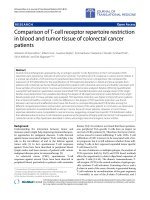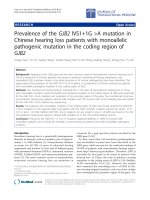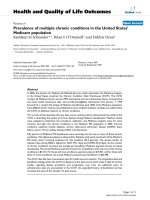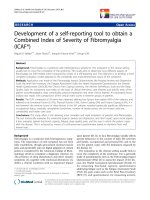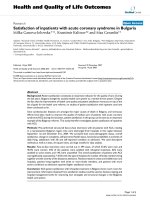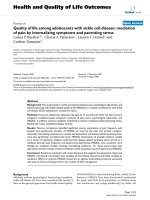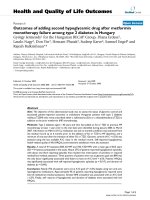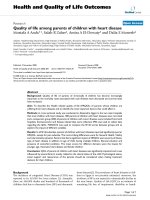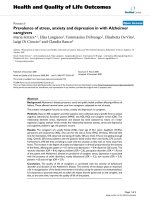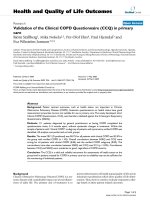báo cáo hóa học:" Prevalence of HIV among injection drug users in Georgia" doc
Bạn đang xem bản rút gọn của tài liệu. Xem và tải ngay bản đầy đủ của tài liệu tại đây (240.81 KB, 7 trang )
RESEARCH Open Access
Prevalence of HIV among injection drug users
in Georgia
Ivdity Chikovani
1*
, Ketevan Goguadze
1
, Sudit Ranade
2
, Mollie Wertlieb
2
, Natia Rukhadze
1
, George Gotsadze
1
Abstract
Background: Injection drug use remains a major risk factor for HIV transmission in Georgia. The study aims to
characterize the prevalence of HIV among injection drug users in Georgia.
Methods: A cross-sectional, anonymous bio-behavioural survey to assess knowledge and behaviour in injection
drug users in combination with laboratory testing on HIV status was conducted in five Georgian cities (Tbilisi, Gori,
Telavi, Zugdidi and Batumi) in 2009. A snowball sample of 1127 eligible injection drug user participants was
investigated.
Results: Odds of HIV exposure were increased for injection drug users of greater age, with greater duration of
drug use and with a history of imprisonment or detainment (p < 0.05).
Conclusions: More research is required to analyze the determinants of HIV risk in Georgian injection drug users.
The imp risoned population and young injection drug users may be appropriate target groups for programmes
aimed at preventing HIV transmission.
Background
Injection drug use is the primary route of HIV transmis-
sion in Eastern Europe [ 1]. An exceptionally high HIV
prevalence among injection drug users (IDUs) is well
documented in Ukra ine and Ru ssia. The Baltic States,
which experienced a rapid increase in HIV among IDUs
in 2001-02, have recently reported declines in this high-
risk group. In contrast, G eorgia and other countries in
the region are reporting increasing cases of HIV among
IDUs [2].
Georgia is categorized as a low-HIV-prevalence coun-
try [3]. The estimated prevalence among the adult popu-
lation is 0.1% [1]. According to the national HIV registry
data, there has been a sharp increase in newly diagnosed
cases since 2004, with a steady increase since 2008.
Annually, almost half of t he newly diagnosed cases are
revealed at the AIDS stage of disease. There is regional
heterogeneity in HIV prevalence with higher rates in the
capital (Tbilisi), regions bordering T urkey, and in the
conflict zone of Abkhazia [3]. Injection drug use
remains a major risk f actor for H IV transmission. I n
2009, more than 70% of new HIV infections were
attributed to injection drug use or sexual contact with
an injection drug user [2].
Drug abuse and its related health and social conse-
quences are critical challenges facing Georgia. As a
bridge between Europe and Asia, Georgia and other
south Caucasian countries serve as a drug trafficking
route into Russia and Europe. The conflict regions may
also have conditions that support drug trafficking. No
reliable estimates on the extent of drug u se in Georgia
currently exist [4].
Over the past few years, Georgia’ sgovernment,
together with international donor organizations, has
been strengthening HIV surveillance an d preventive
efforts among high-r isk groups. Second-generation sur-
veillance has been initiated in IDUs since 2002 [ 3,5].
Several rounds of bio-behavioural surveillance surveys
(Bio-BSS) have been conducted in the capital and
other cities. This paper reports on the findings of Bio-
BSS that were conducted in five cities in Georgia in
2008-09 using a respondent-driven sampling (RDS)
methodology as part of a Global Fund-supported
project, and aims to identify HIV risk determinants
among IDUs.
* Correspondence:
1
Curatio International Foundation, Tbilisi, Georgia
Full list of author information is available at the end of the article
Chikovani et al. Journal of the International AIDS Society 2011, 14:9
/>© 2011 Chikovani et al ; licensee BioMed Central Ltd. This is an Open Access article dist ributed under the terms of the Creative
Commons Attribution License ( , which permits unrestricted use, distri bution, and
reproduction in any medium, provided the original work is properly cited.
Methods
Five cross-sectional, anonymous surveys of IDUs were
conducted in Tbilisi, Batumi, Zugdidi, Gori and Telavi
in 2009. Participants were recruited by using RDS meth-
odology. RDS is a variant of chain-referral sampling
used to reach hidden populations [6,7]. R DS provides a
probabilis tic sample of a researched sub-population in a
given location, and a specially developed software pack-
age (RDSAT) generates sample weights that account for
network sizes and the degree of homophily. In the cur-
rent analyses, a non-weighted combined dataset from all
five studies was used. Therefore, the sample should be
considered as a standard snowball.
The study inclusion criteria were as follows: aged 18
years or older; drug injection in the month prior to the
survey; and be ing a resident of the selected survey loca-
tion. The interviews were conducted at fixed sites located
in the ce ntre of each city by trained interviewers from
the local non-governmental organization, “Bemoni,”
which has extensive experience working with IDUs.
Those who were eligible to participate in the study
went through the informed consent procedure. In a pri-
vate area, the participant was informed about the study,
and if willing to participate, he/she signed a consent
form. Following consent, the survey was conduct ed and
participants were asked to voluntarily provide a blood
sample for HIV testing. Tests were anonymously linked
to the participants. The Genscreen
®
Ultra HIV rapid test
was used for HIV screeni ng. HIV-positive samples were
tested with a Western Blot (HIV Blot 2.2, Genelabs Diag-
nostics) confirmatory test. Respondents were asked to
come with their identification card to receive their
results. Post-test counselling was provided on site, and
respondents t esting positive for HIV were referred to a
designated centre, where free treatment services were
available.
The study protocol and questionnaires were approved
by the Ethics Review Committee of the HIV/AIDS
Patient s Support Association, Georgia. Overall, 1127 eli-
gible IDUs, including seeds, participated in the Bio-BSS
studies in Tbilisi, Batumi, Zugdidi, Telavi and Gori.
Univariate and multivariate l ogistic regressions were
used to evaluate predi ctors of HIV prevalence . Analyses
were done for the combi ned samples from all five study
locations.
The factors included in the univari ate analyses were:
age; education; duration of drug use; frequency of injec-
tion; age at first use; being part of a regular injecting
group; having injected in ano ther city/country during the
previous year; having ever shared a syringe; unsafe injec-
tion practices at last injection; condom use at last inter-
course and during the previous year with any type of
partner; type of drug injected; history of imprisonment/
detainment; and city of residence. Those factors that
were statistically significant in the univariate analysis
were further included in the multivariate stepwise logistic
regression model. Analyses were done in Stata 11 (Stata
Corp, College Station, Texas, USA) and p < 0.05 was
taken as a statistically significant.
Results
Sample characteristics
Table 1 provides major characteristics of the sample of
IDUs. The median age of study participants was
35 years. The majority of participants were ethnically
Georgian males. Ethnic distribution of the sample corre-
sponds to the Georgian population’s ethnic composition,
where 84% are Georgians [8]; however, it is questionable
whether the gender composition of participants is repre-
sentative of the true IDU population. In total, 49.7% of
respondents were married. The median age for starting
any type of drug use was 17 years, and for injecting
drugs, the median age at first use was 19 years. All
IDUsacrossallfivesurveylocationshadheardabout
HIV/AIDS, and almost 50% knew a person who has
been infected, became ill or died of AIDS. The majority
of IDUs had knowledge about how HIV is transmitted
and how its transmission can be prevented. Most
(99.4%) knew that sharing syringes increases the risk for
contrac ting HIV; 97% reported that they could get new,
unused syringes when needed; and 94.9% mentioned
drug store as a prime source of syringes.
Most IDUs correctly identified that proper condom
use (96.2%), having only one sexual partner who is unin-
fected (92.8%), and switching to non-injection drugs
(93.5%) can reduce the risk of contracting HIV. Less
than one-third of the sample had ever b een tested f or
HIV. More than half (59.1%) of respondents reported
ever sharing syringes, and only 6.1% had shared at last
injection. Joint use of injection paraphernalia at last
injection was reported by 46.4% of IDUs. IDUs had, on
average, three sexual partners during the previous
12 months. Of the married respondents who also had a
sexual relationship with an occasional partner, 5 2% did
not use a condo m at the time of th eir last sexual inter-
course with their extramarital partner. Various propor-
tions of IDUs were reached by preventive programmes,
such as syringe and condom distribution, HIV testing
and educational information provision (Table 1). How-
ever , based on this sample, only 13.9% of IDUs received
condoms from preventive programmes and were tested
for HIV during the previous 12 months.
Biomarker testing was completed for 1108 participants
out of the total sample of 1127 IDUs. Twenty-two peo-
ple (1.99%) tested positively for HIV. The prevalence
ranges from 0% in Gori, 1.5% (95% C I 0.3-4.3) in Telavi
Chikovani et al. Journal of the International AIDS Society 2011, 14:9
/>Page 2 of 7
and 1.5% (95% CI 0.3-4.3) in Zugdidi to 2.3% (95% CI
0.9-4.8) in Tbilisi and 4.4% (95% CI 1.9-8.4) in Batumi.
Logistic regressions
The univariate analysis of HIV prevalenc e (Table 2)
revealed that the indicators associated with increased
risk of HIV are age (p = 0.013), longer duration of drug
use (p = 0.001), a nd having a history of imprisonment
or detainment (p = 0.014). IDUs aged 31 to 40, and
older than 41, had higher odds for being HIV positive:
10.8 (95% CI 1.4 - 84.5) and 11.2 (95% CI 1.4-88.2),
respectively, compared with those younger than 30 year s
old. IDUs who had been injecting drugs longer than
zerotofouryearsweremorelikelytobeHIVpositive:
the OR for HIV-positive status among those injecting
drugs for five to nine years was 1.45 (95% CI 0.2-10.4)
compared with the reference category, and for those
injecting for more than 10 years, the OR was 7.41 (95%
CI 1.7-32.2). Being HIV positive was associated with
more than three times the odds of having been impri-
soned or detained (OR 3.29, 95% CI 1.2-8.9).
Marginally significant association was found between
frequency of injection and HIV positivity. Those who
did not inject during the previous week had lower odds
of having HIV compared with more frequent injectors.
In choosing variables for the multivariate regression
model, duration of use and age showed positive correla-
tion (Pearson correlation between duration of drug use
and age was 0.67; p < 001). Since the duration of drug
userepresentedamorevaluablecausalconnectionto
explore than age, the age variable was dropped from the
model. The multiple logistic regression of HIV preva-
lence (Table 3) yields the resul t that the duratio n of
drug use is a significant predictor of the risk of HIV in
this population (p = 0.009). There were no significant
interactions among these variables.
The remaining variables, which had been significant in
the univariate analysis, were no longer statistically signif-
icant in the multivari ate model. To explore the relation-
ship between HIV prevalence, condom use at last sexual
intercourse, and regular condom use categorized by type
of partner, an additional logistic regression was run. The
regression revealed that none of these p redictors have
significant associations with HIV risk (p > 0.05).
Discussion
Our analysis r aises a number of interesting issues for
discussion. The prevalence of HIV among IDUs in the
neighbouring countries of Turkey (1.5%) and Armenia
(6.8%) is similar to that of Georgia, ranging between
2.5% and 4.5% [3,9,10]. In other nearby former Soviet
Uni on countries, the rate is higher: 10.3% prev alence in
Table 1 Basic characteristics of IDUs in five cities in
Georgia, 2009
Characteristic
Overall N = 1127
Age (median years) 35
Male 98.7%
Georgian 95.3%
Residency:
Tbilisi 27.2%
Gori 18.2%
Zugdidi 18.2%
Telavi 18.1%
Batumi 18.3%
Education:
Primary/secondary 54.9%
Incomplete higher/higher 45.1%
Married 49.7%
Internally displaced person 1.9%
Ever imprisoned 11.9%
Age of first drug use (median years) 17
Age of first drug injection (median years) 19
Ever shared syringe (yes) 59.1%
At last injection injected with shared syringe or left
at a place of gathering (yes)
6.1%
At last injection injected with prefilled syringe used
by somebody else (yes)
2.4%
At last injection shared paraphernalia (yes) 46.4%
Ever tested for HIV 28.9%
Tested for HIV during last 12 months 6.0%
Received condoms from preventive programmes
during last 12 months
15.8%
Received syringes from preventive programmes
during last 12 months
25.1%
Received qualified information on HIV/AIDS during
last 12 months
17.8%
Received condoms from preventive programmes
and tested for HIV during last 12 months
13.9%
Can get new unused syringes when needed 97.0%
Can get new unused syringes from drug store 94.9%
Knowledge:
Healthy looking person can be HIV infected (yes) 89.3%
One can reduce HIV risk if properly uses
condoms during every sexual contact (yes)
96.2%
One may protect himself from HIV by having
one uninfected and reliable sexual partner (yes)
92.8%
One may be infected with HIV by using a
syringe already used by someone else (yes)
99.4%
Male to male sexual relationship N = 1112 1.7%
Number of female sexual partners during last
12 months (median)
3
Always condom use with regular partners N = 870 10.2%
Always condom use with occasional partners N = 550 29.6%
Always condom use with paid sex partners N = 316 63.9%
Tested HIV positive N = 1108 1.99%
Chikovani et al. Journal of the International AIDS Society 2011, 14:9
/>Page 3 of 7
Table 2 Univariable predictors of anti-HIV positivity among IDUs in five cities in Georgia, 2009
Characteristic HIV+/total % HIV+ OR 95% CI P value
1
Age (years)
30 and under 1.0
31-40 10.8 1.4-84.5
41 and over 11.2 1.4-88.2 0.013
Education
Primary/secondary 13/611 2.1 1.0
Incomp. higher/higher 9/497 1.8 0.85 0.4-2.0 0.707
Duration of drug use
0-4 years 2/376 0.5 1.0
5-9 years 2/260 0.8 1.45 0.2-10.4
10+ years 18/472 3.8 7.41 1.7-32.2 0.001
Frequency of injection
Not in last week 6/553 1.1 1.0
<Daily 13/405 3.2 3.02 1.1-8.0
Daily 3/145 2.1 1.92 0.5-7.8 0.067
Age at first use (years)
Under 15 5/213 2.3 1.0
15-19 14/721 1.9 0.83 0.3-2.3
20-24 3/136 2.2 0.94 0.2-4.0 0.812
25+ 0/38 - -
Part of regular injecting group
Yes 18/782 2.3 1.0
No 4/326 1.2 0.53 0.2-1.6 0.243
Injected in another city/country in last year
Yes 12/488 2.4 1.0
No 10/620 1.6 1.5 0.7-3.6 0.316
Ever shared a syringe
Yes 17/653 2.6 1.0
No 4/437 0.9 0.43 0.2-1.2 0.102
Engage in safe drug practice at last injection
2
Yes 12/535 2.2 1.0
No 10/573 1.7 0.77 0.3-1.8 0.553
Condom use with any partner at last intercourse
Yes 7/241 2.9 1.0
No 10/778 1.3 0.44 0.2-1.16 0.086
Always condom use with any partner in last year
Yes 3/101 3.0 1.0
No 19/985 4.9 1.5 0.4-5.3 0.490
Type of drug used last month
Ephedrone
3
2/95 2.1 1.0
Subutex
®4
1/197 0.5 0.24 0.02-2.6
Heroin 11/381 2.9 1.4 0.30-6.3
Other 1/34 2.9 1.4 0.12-16.0
Multiple 7/401 1.7 0.82 0.17-4.0 0.394
History of imprisonment or detainment
No 5/539 0.9 1.0
Yes 17/569 3.0 3.29 1.2-8.9 0.014
Chikovani et al. Journal of the International AIDS Society 2011, 14:9
/>Page 4 of 7
Azerbaijan [11], 30.1% in the capital city of the Russian
Federation, and 22.9% in Ukraine [1,12].
It is interesting to note that the HIV prevalence, while
low, is increasing in Georgia [2], and the highest preva-
lence of HIV was noted in a major urban area (Tbilisi)
and/or geographically near the border of the country
(Batumi). Previous Bio-BSS among IDUs carried out i n
these locations in 2004 revealed an HIV prevalence of
0.4% in Tbilisi and 2.1% in Batumi [13,14]. Comparison
with our study findings demonstrates increases in HIV
prevalence in both locations, with a statistically signifi-
cant change for Tbilisi IDUs (p < 0.05). This may be
important for the identification of pote ntial entry po ints
for HIV prevention programming.
No association was found between high-risk injection
behaviour at last injection (use of share d syringe, use of
potentially contaminated syringe, and joint use of inject-
ing paraphernalia) and HIV positivity. It is not likely
that IDUs underreport engagement in unsafe injecting
practicesasthereisgeneralconsensusthatIDUsdo
reliably report such behaviours in studies of this type
[15]. However, we measured injecting behaviour at last
injection, which may substantially differ from behaviour
during previous injections.
The alarmingly high prevalence of hepatitis B virus
(HBV) and hepatitis C virus (HCV) among IDUs in
Georgia is an indicator of unsafe injecting practice,
which IDUs may have engaged in during their injecting
career. In all, 64.6% of IDUs tested in Tbilisi in 2006
were infected with HCV [13]. In a 2000-01 study, a pre-
valence of 55.2% of HBV-positive cases was identified
[16]. This corresponds to the finding of our study that
59.1% of IDUs have ever used a shared syringe. It is
notable that a comparison of syringe sharing at last
injection with the 2002-04 Bio-BSS results showed a
reduction in this behaviour among Tbilisi and Batumi
IDUs, with a statistically significant reduction among
the Tbilisi sample (from 15.3% in 2002 to 3.4% in 2009,
p < 0.05) [13,14]. Prevalence of other risk factors, such
as joint use of injecting paraphernalia remains high
(46.4%).
The multivariate analysis revealed duration of injec-
tion as the major predictor of HIV risk. This finding is
not surprising since as the duration of injection drug
use increases, clearly the risk of HIV increases by
repeated exposure and via po tentially un safe drug
practices.
As a predictor of HIV exposure, a history of imprison-
ment or detainment also raises important issues for the
prevention of HIV in Georgia. It i s well d ocumented
that imprisonment, which is common among IDUs, is
associated with elevated HIV risk. Studies indicate that
there have been prison-based HIV outbreaks in Russia,
Lithuania [17,18] and many other countries [19-21].
While drug injection frequency may decrease in the
prisons, there is a greater risk of syringe sharing among
imprisoned individuals due to restricted syringe avail-
ability. Syringe-exchange programmes within prisons are
highly controve rsial, although some European countries
[22], as well as Moldova, Belarus and Kyrgyzstan among
former Soviet Union countries, have i ntroduced such
programmes in their prisons. Among o ther preventive
Table 3 Multivariable predictors of anti HIV positivity
among IDUs in five cities in Georgia, 2009
Predictor Odds Ratio 95% CI P-value
1
Duration of drug use
0-4 years 1.0
5-9 years 1.3 0.18-9.6
10+ years 6.4 1.4-27.9 0.014
Injection frequency
Not in the last week 1.0
<Daily 3.0 1.02-8.7
Daily 2.0 0.4-9.6 0.128
History of imprisonment/detention
No 1.0
Yes 2.2 1.0-7.5 0.051
1
- P value obtained from Wald’s test.
Table 2 Univariable predictors of anti-HIV positivity among IDUs in five cities in Georgia, 2009 (Continued)
City of residence
Tbilisi 7/306 2.3 1.0
Gori 0/187 - -
Telavi 3/205 1.5 0.63 0.2-2.5
Zugdidi 3/204 1.5 0.64 0.2-2.5
Batumi 9/206 4.4 1.95 0.7-5.3 0.174
1
- P value derived from x
2
test.
2
- Safe injecting practice at last injection was measured by combination of different indicators, such as: not usage of previously used syringe, not usage of
syringe left at a place of gathering by somebody else, not usage of prefilled syringe, not usage of shared equipment, not usage of drug solution from shared
container, not usage of liquid diluted with somebody else’s blood.
3
- Self-made amphetamine type stimulant.
4
- Buprenorphine.
Chikovani et al. Journal of the International AIDS Society 2011, 14:9
/>Page 5 of 7
schemes, drug-substituti on therapy has proven its effec-
tiveness in HIV risk reduction. Regrettably, such services
are only now starting to become available in Georgian
prisons, and only in pre-detention facilities. While there
are often political barriers to the implementation of
harm-reduction interventions in correctional institu-
tional settings, this analysis identifies a potentially vul-
nerable sub-population towards whom interventions
should be directed.
Although coverage of IDUs by comprehensive preven-
tive programmes was low, the programmes had reached
their clients thro ugh various d iscrete interventions. In
this study, close to 100% of participants had been
exposed to HIV prevention information. The IDUs,
regardless of their HIV status, were also well informed
about the modes of HIV transmission. Satisfactory
knowledge, combined with easy access to disposable syr-
inges from pharmacies, could be an expla nation of rela-
tively low syringe sharing as the riskiest behaviour in
HIV transmission, thus contributing to low H IV preva-
lence among IDUs so far.
There are, however, factors at micro- an d macro-
environmental levels that confer risk for HIV infection
[23]. At micro-environmental level, the study shows low
HIV testing uptake among IDUs. This corresponds to
the national HIV statistics data that a significant propor-
tion of cases a re identified at a late stage, when AIDS
has already developed. This is especially concerning
given very low condom use among IDUs with their reg-
ular sexual partners. At the macro level, proximity to
drug traffi cking and distribution routes and exposu re to
war are known to influence risk of HIV acquisition [23].
Both factors exist in Georgia, as the country is situ-
ated o n the Silk Route (or North Route) of opiate traf-
ficking from Afghanistan, and there are unresolved
conflict areas in the northern parts of Georgia. Accord-
ing to the World Drug Report, opiate seizures have
been declining through the Silk Route [24], but at the
same time, the Georgian Internal Services reports a sub-
stantial increase of illegal smuggling of buprenorphine
from European countries [4]. All of this re-emphasizes
the need for structural HIV prevention interventions.
The prevention of HIV transmission in this sub-
population, therefore, may lie in strengthening beha-
viour-modification and harm-reduction programmes,
including interventions to increase HIV testing, rather
than through education and informational program-
ming. A foll ow-up analysis is being conducte d to review
the matching of this knowledge with risk behaviours in
this population.
As w ith any study, this s urvey and analysis has some
limitations. Although RDS methodology was used to
study IDUs in different locations, the analyses presented
in the paper are based on the combined unweighted
datasets, and therefore they may not be sufficiently gen-
eralizable. Also, women and IDUs younger than
25 years of age were not sufficiently represented in the
sample. Finally, a reporting and recall bias common to
all BSS studies may also exist.
Conclusions
This data was collected with the intent that it should be
used for the purposes of intervention planning, advocacy
and policy making. The existing coverage of HIV pre-
vention p rogrammes in Georgia to the IDU population
is less than 20% [3], and this study demonstrates that
coverage remains at an unsatisfactory level. Therefore
behaviour changes, as well asstructuralandsystems
improvements, will be required to implement gains in
HIV prevention. More research is required to analyze
the determinants o f HIV risk in Georgian IDUs. The
imprisoned population and young IDUs may be appro-
priate target groups for programmes aimed at prevent-
ing HIV transmission.
Acknowledgements
The fieldwork of the study was completed as part of the Global Fund to
Fight AIDS, Tuberculosis and Malaria-supported project, “Establishment of
evidence base for the HIV/AIDS national program, through strengthening of
the surveillance system” (contracts: GF/A-R6/S-I-01, GF/A-R6/S-I-02). The data
analyses was funded by Curatio International Foundation. The authors would
like to express gratitude to Tamara Sirbiladze, Lela Tavzarashvili, Ivana
Bozicevic, Lucija Zigrovic, Tamara Kasrashvili, Manana Gvaberidze, staff
members of the public union, “Bemoni”, and all study participants.
Author details
1
Curatio International Foundation, Tbilisi, Georgia.
2
Johns Hopkins University,
Baltimore, USA.
Authors’ contributions
GG undertook study conception and design, and critical revision of the
manuscript. IC was responsible for acquisition of data, analysis and
interpretation of data, and drafting of the manuscript. KG undertook
acquisition of data, and drafting of the manuscript. NR undertook acquisition
of data. SR was responsible for analysis and interpretation of data, and
drafting of the manuscript. MW was responsible for analysis and
interpretation of data, and drafting of the manuscript. All authors read and
approved the final manuscript.
Competing interests
The authors declare that they have no competing interests.
Received: 30 June 2010 Accepted: 15 February 2011
Published: 15 February 2011
References
1. Joint United Nations Programme on HIV/AIDS: Global report: UNAIDS report
on the global AIDS epidemic 2010 [ />20101123_GlobalReport_em.pdf].
2. European Centre for Disease Prevention and Control/WHO Regional Office
for Europe: HIV/AIDS surveillance in Europe 2009. Stockholm 2010 [http://www.
ecdc.europa.eu/en/publications/Publications/101129_SUR_HIV_2009.pdf].
3. Monitoring the Declaration of Commitment on HIV/AIDS: Georgia Country
Progress Report 2010 [ />georgia_2010_country_progress_report_en.pdf].
4. Javakhishvili JD, Sturua L, Todadze K, Todadze K, Skhvitaridze Z, Kirtadze I,
Zabransky T, Connor G, Nozadze P, Zakharashvili T: 2009 National report to
Chikovani et al. Journal of the International AIDS Society 2011, 14:9
/>Page 6 of 7
The European Monitoring Centre for Drugs and Drug Addiction: Georgia drug
situation Tbilisi, Georgia: United Nations Development Programme/South
Caucasus Anti-Drug Programme; 2009 [ />news/drug-2009-eng-www.pdf].
5. Curatio International Foundation: Assessment of the HIV Surveillance System
Tbilisi, Georgia; 2008 [ />178_2.pdf].
6. Heckathorn DD: Respondent driven sampling: a new approach to the
study of hidden populations. Social Problems 1997, 44:174-199.
7. Heckathorn DD: Respondent driven sampling, II: deriving population
estimate from chain referral samples of hidden populations. Social
Problems 2002, 49:11-34.
8. National Statistics Office of Georgia: General population census of 2002
[ />9. UNGASS indicators country report, Turkey 2008 [ />Report/2008/turkey_2008_country_progress_report_en.pdf].
10. UNGASS country progress report, Republic of Armenia 2010 [http://data.
unaids.org/pub/Report/2010/armenia_2010_country_progress_report_en.
pdf].
11. UNGASS country progress report, Azerbaijan 2010 [ />pub/Report/2010/azerbaijan_2010_country_progress_report_ru.pdf].
12. National report on monitoring progress towards the UNGASS declaration of
commitment on HIV/AIDS, Ukraine 2010 [ />2010/ukraine_2010_country_progress_report_en.pdf].
13. Dershem L, Tabatadze M, Sirbiladze T, Tavzarashvili L, Todadze K, Tsagareli T:
Characteristics, High-Risk Behaviors and Knowledge of STI/HIV/AIDS, and
Prevalence of HIV, Syphilis and Hepatitis Among Injecting Drug Users in
Batumi, Georgia: 2002 - 2006 Washington D.C: USAID; 2007 [id.
gov/pdf_docs/PNADK404.pdf], updated 2009.
14. Dershem L, Tabatadze M, Sirbiladze T, Tavzarashvili L, Todadze K, Tsagareli T:
Characteristics, High-Risk Behaviors and Knowledge of STI/HIV/AIDS, and
Prevalence of HIV, Syphilis and Hepatitis Among Injecting Drug Users in
Batumi, Georgia: 2004 - 2006 Washington, D.C: USAID; 2007 [id.
gov/pdf_docs/PNADK406.pdf], updated 2009.
15. Darke S, Hall W, Heather N, Ward J, Wodak A: The reliability and validity of
a scale to measure HIV risk-taking behaviour among intravenous drug
users. AIDS 1991, 5:181-185.
16. Shapatava E, Nelson KE, Tsertsvadze T, Rio CD: Risk behaviors and HIV,
hepatitis B, and hepatitis C seroprevalence among injection drug users
in Georgia. Drug and Alcohol Dependence 2006, 82(Suppl 1):S35-38.
17. Bobrik A, Danishevski K, Eroshina K, McKee M: Prison health in Russia: the
larger picture. Journal of Public Health Policy 2005, 26(1):30-59.
18. MacDonald M: A study of health care provision, existing drug services and
strategies operating in prisons in ten countries from central and eastern
Europe Helsinki, Finland: The European Institute for Crime Prevention and
Control/United Nations; 2005 [ />19. Thaisri H, Lerwitworapong J, Vongsheree S, Sawanpanyaler P,
Chadbanchachai C, Rojanawiwat A, Kongpromsook W, Paungtubtim W, Sri-
ngam P, Jaisue R: HIV infection and risk factors among Bangkok
prisoners: a prospective cohort study. BMC Infectious Disease 2003, 3:25.
20. Long J, Allwright S, Barry J, Reynolds S, Thornton L, Bradley F, Parry J, Bird S:
Prevalence of antibodies to hepatitis B, hepatitis C, and HIV and risk
factors in entrants to Irish prisons: a national cross sectional survey.
British Medical Journal 2001, 323(7323):1209-1213.
21. Werb D, Kerr T, Small W, Strathdee S, Montaner J, Kerr T: HIV risks
associated with incarceration among injection drug users: implications
for prison-based public health strategies. Journal of Public Health (Oxf)
2008, 30:126-132.
22. World Health Organization Regional Office for Europe: Status Paper on
Prisons, Drugs and Harm Reduction. Copenhagen 2005 [o.
who.int/document/e85877.pdf].
23. Strathdee S, Hallet T, Bobrova N, Rhodes T, Booth R, Abdool R, Hankins CA:
HIV and risk environment for injecting drug users: the past, present and
future. Lancet 2010, 376:268-284.
24. United Nations Office on Drug and Crime: World Drug Report 2009 2009
[ />pdf].
doi:10.1186/1758-2652-14-9
Cite this article as: Chikovani et al.: Prevalence of HIV among injection
drug users in Georgia. Journal of the International AIDS Society 2011 14:9.
Submit your next manuscript to BioMed Central
and take full advantage of:
• Convenient online submission
• Thorough peer review
• No space constraints or color figure charges
• Immediate publication on acceptance
• Inclusion in PubMed, CAS, Scopus and Google Scholar
• Research which is freely available for redistribution
Submit your manuscript at
www.biomedcentral.com/submit
Chikovani et al. Journal of the International AIDS Society 2011, 14:9
/>Page 7 of 7
